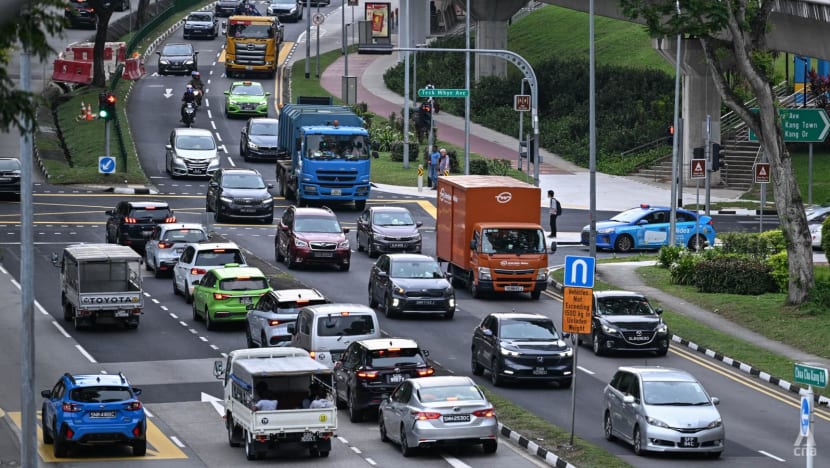Commentary: When it comes to penalties for dangerous and careless driving, what’s fair and effective?
The Singapore government said that penalties for errant driving are “already quite stiff”, but this view does not appear to be shared by the public. Lawyer Mark Yeo weighs in.

A view of traffic in Singapore. (File photo: Â鶹/Lan Yu)

This audio is generated by an AI tool.
SINGAPORE: Few things trigger Singaporeans more than watching people drive badly. From online forums to Facebook pages dedicated to naming and shaming bad drivers, this issue occupies a unique space in the Singaporean psyche.
However, bad driving is more than just a pet peeve. According to the Singapore Police Force, the number of traffic accidents resulting in death increased to 139 in 2024 from 131 in 2023 and 104 in 2022. This figure represents a five-year high.
Over the years, the government has taken steps to deter irresponsible driving. In 2019, lawmakers significantly increased the maximum sentences that may be imposed for careless and dangerous driving, as well as drink driving.
The government stated in parliament on May 7, 2024 that the penalties for errant driving were “already quite stiff”, but this view does not appear to be shared by the public.
For example, when a 37-year-old driver was sentenced to one year's imprisonment after a fatal hit-and-run accident, the overwhelming public sentiment online was that the sentence he received was a mere slap on the wrist, considering that a life was lost.
Therefore, when parliament passed a law on Jan 7 removing mandatory minimum sentences for first-time dangerous and careless driving offenders, many parliamentarians raised concerns as to whether or not the authorities were going soft on such offences.
Why do road traffic laws appear too lenient and too stiff at the same time? And what can be done about it?
CARELESS OR DANGEROUS DRIVING EXPLAINED
To understand why such a disparity in opinions exists, the penalties for careless or dangerous driving must first be explained.
A driver commits an offence of careless driving if he drives without due attention and consideration for other road users. For instance, he fails to spot a motorcyclist coming in the opposite direction when making a discretionary right turn or U-turn, leading to a collision between the two vehicles.
Meanwhile, offences of dangerous driving entail driving at a reckless speed or manner that endangers others. Common examples include beating a red light or driving against the flow of traffic.
The punishment for careless and dangerous driving depends on whether the accident resulted in injury or death. If no hurt was caused due to the careless driving, the maximum punishment for a first offender is six months’ imprisonment. However, if death is caused, the maximum imprisonment term increases to three years.
Enhanced penalties are also imposed on repeat offenders and “serious offenders” – offenders who commit careless or dangerous driving while drink driving. Where the offender flees the scene without stopping to render assistance, separate charges may be brought for that.
PUNISHING OUTCOMES RATHER THAN INTENTIONS
Crucially, neither careless nor dangerous driving are offences of intention. If the offender intended to cause hurt or death by intentionally getting into an “accident”, he may be charged under the Penal Code for voluntarily causing hurt or grievous hurt, or even an offence of murder. These, naturally, will attract significantly harsher penalties.
Therefore, when assessing the adequacy of punishments for road traffic accidents, it is important to remember that these are, at their root, accidents. Offenders are punished for the outcome of their actions, rather than their intentions.
Consider the following scenario: A motorist driving along an expressway decides to filter from one lane to another. After checking that the next lane is clear, he executes the lane change.
However, he fails to see a motorcyclist riding in between two lanes coming his way, and sideswipes the motorcyclist. The motorcyclist is flung off his motorcycle and suffers injuries which ultimately prove to be fatal.
How should this motorist be punished? On one hand, the motorist made an error of judgment that is, in the grand scheme of things, minor. However, it resulted in the loss of life. Depending on which perspective you take, your view on the harshness or leniency of the sentence may vary significantly.
Consider again a variation of the scenario above. Although the motorist does not see the motorcyclist, the motorcyclist sees the car changing lanes, and slows down, thus avoiding an accident. Even though the driver was equally careless in both instances, he is not punished in this second scenario. The difference is striking.
CALIBRATING THE PUNISHMENT TO SUIT THE OFFENCE
How then can the gap between how stiff the penalties for road traffic offences are versus how the public perceives them be reduced?
For a start, it is important to ensure that the offender is charged under the right offence provision, consistent with the severity of his actions.
This may be done by clearly delineating what constitutes careless or dangerous driving, either by parliament providing examples of such offences in the legislation itself, or through the courts providing guidance in cases that come before it.
When the boundaries between careless and dangerous driving are clearly set, it would allow the prosecution to bring more appropriate charges against errant drivers, so that the punishment befits the crime.
Second, clear and consistent sentencing frameworks and guidelines are important in helping the public understand the penalties for careless and dangerous driving. Due to the many permutations of traffic offences, there is presently no unifying sentencing framework that covers the whole spectrum of offences related to traffic accidents.
To that end, the Sentencing Advisory Panel is looking at issuing guidelines for dangerous and careless driving offences, to enhance sentencing consistency and public understanding.
Finally, as I wrote in a previous commentary, we should remember that there are many factors that go into the eventual sentence that an offender receives. These include the nature and number of charges brought against the accused person, as well as the maximum and minimum punishments that can be imposed.
It is in this context that the court exercises its discretion to impose a just and appropriate sentence on the accused. While such sentences may at times seem lenient, the court’s goal in sentencing is to ensure consistency in sentencing and, thus, fairness.
Ultimately, it may well prove impossible to eradicate the disparity between the government’s policy intent and public opinion. However, having clearer guidelines and principles would help people understand how and why sentences are imposed for traffic offences.
Mark Yeo is a Director at Fortress Law Corporation. He was formerly a Deputy Public Prosecutor with the Attorney-General’s Chambers.















